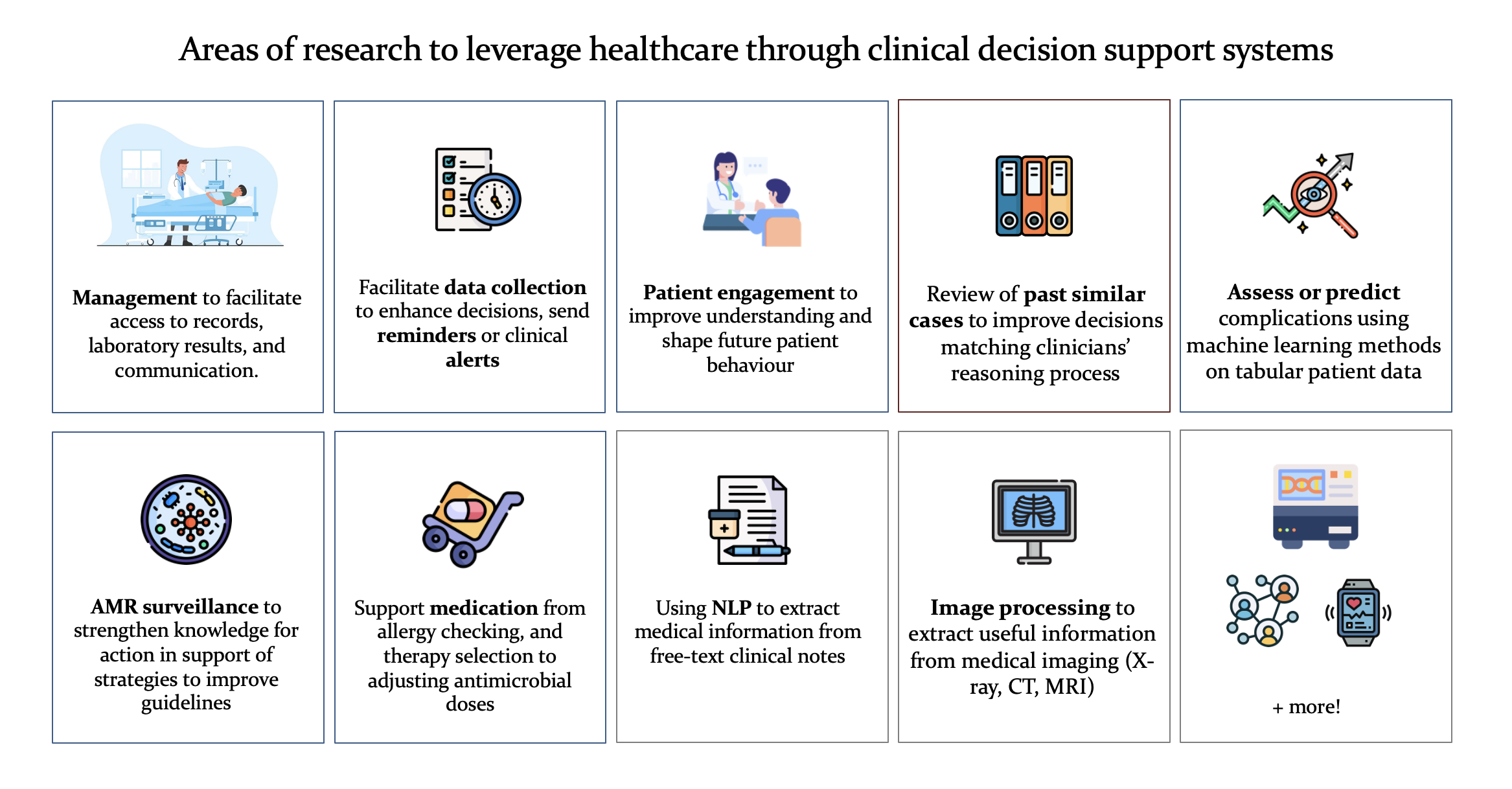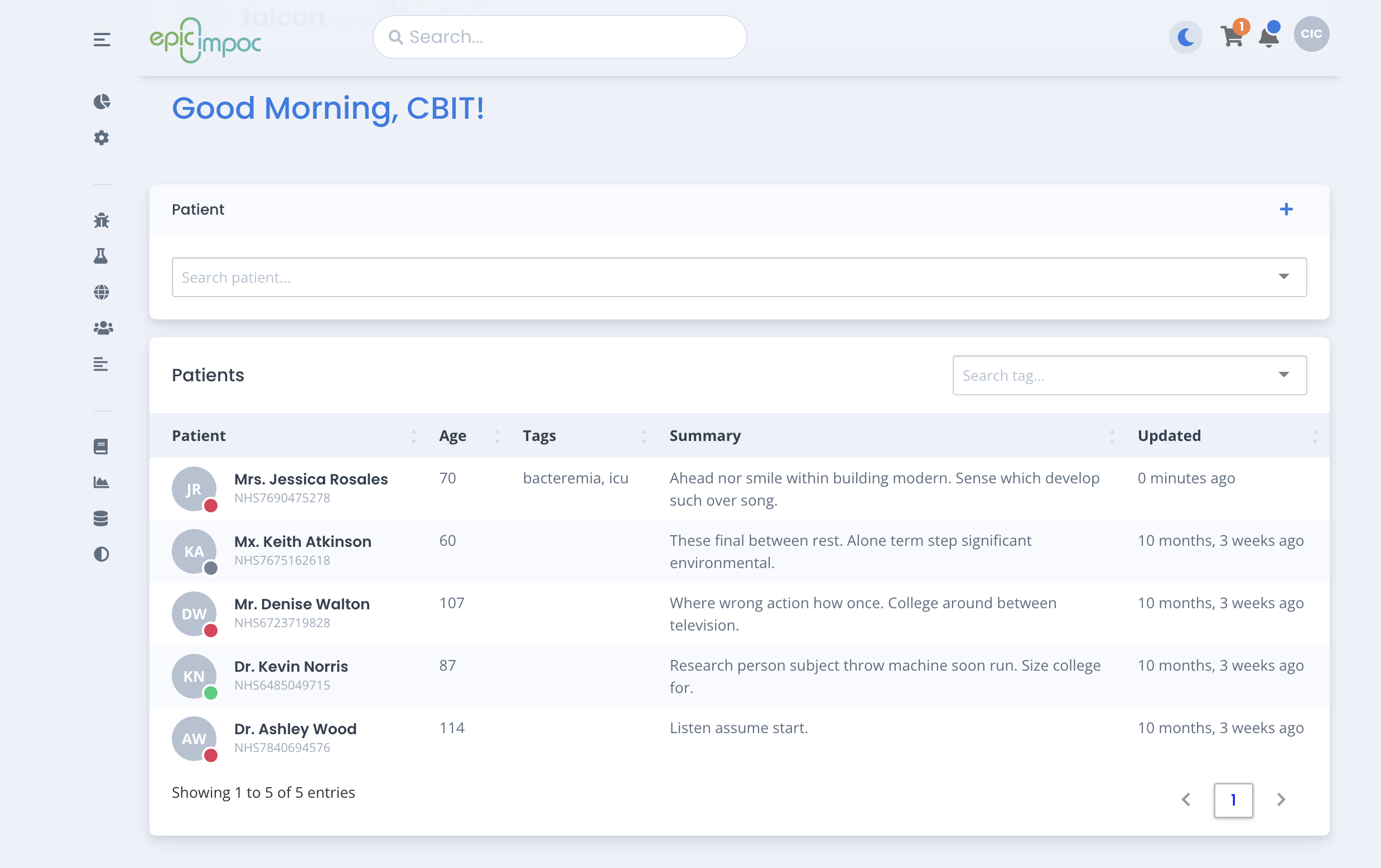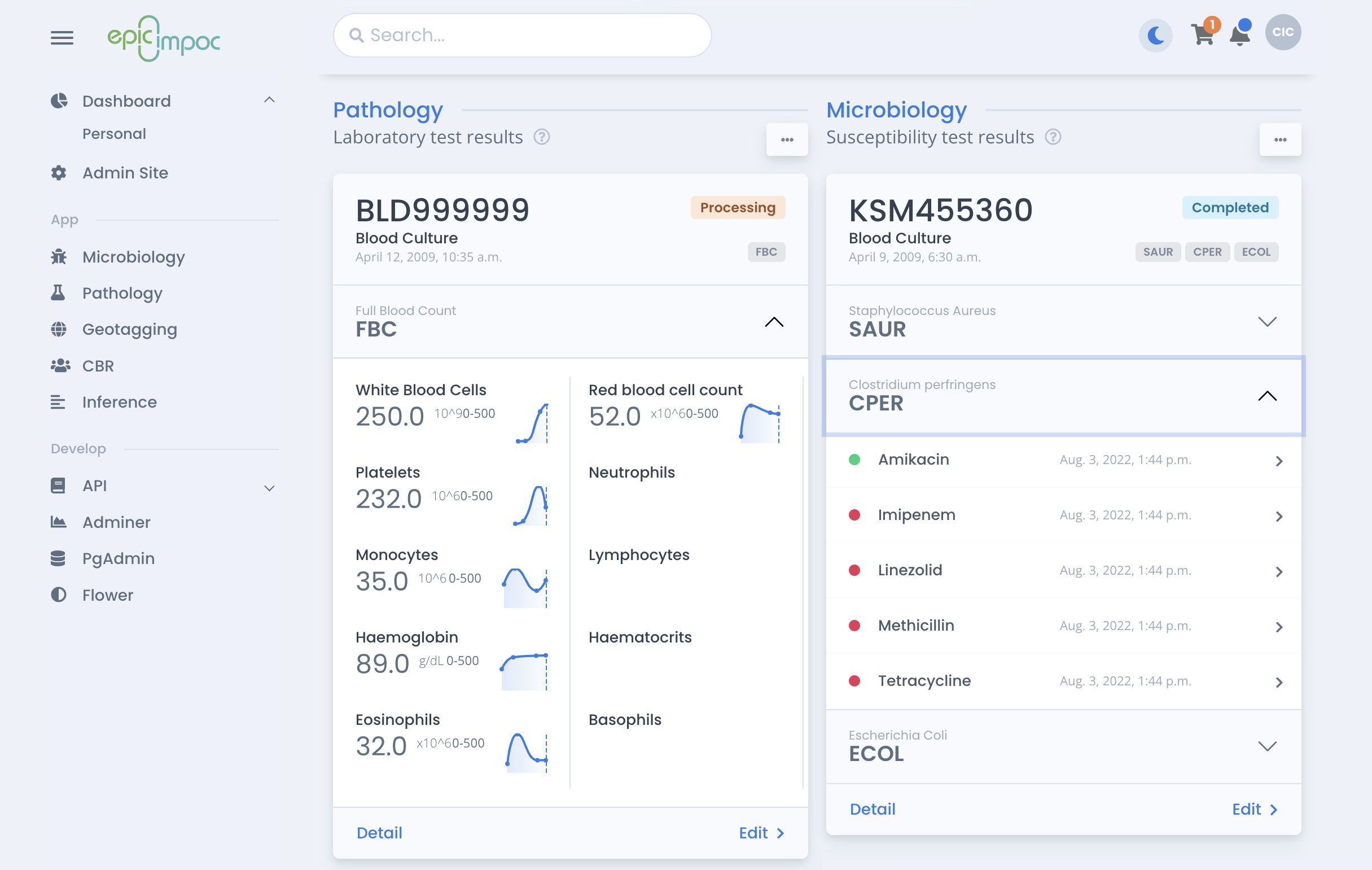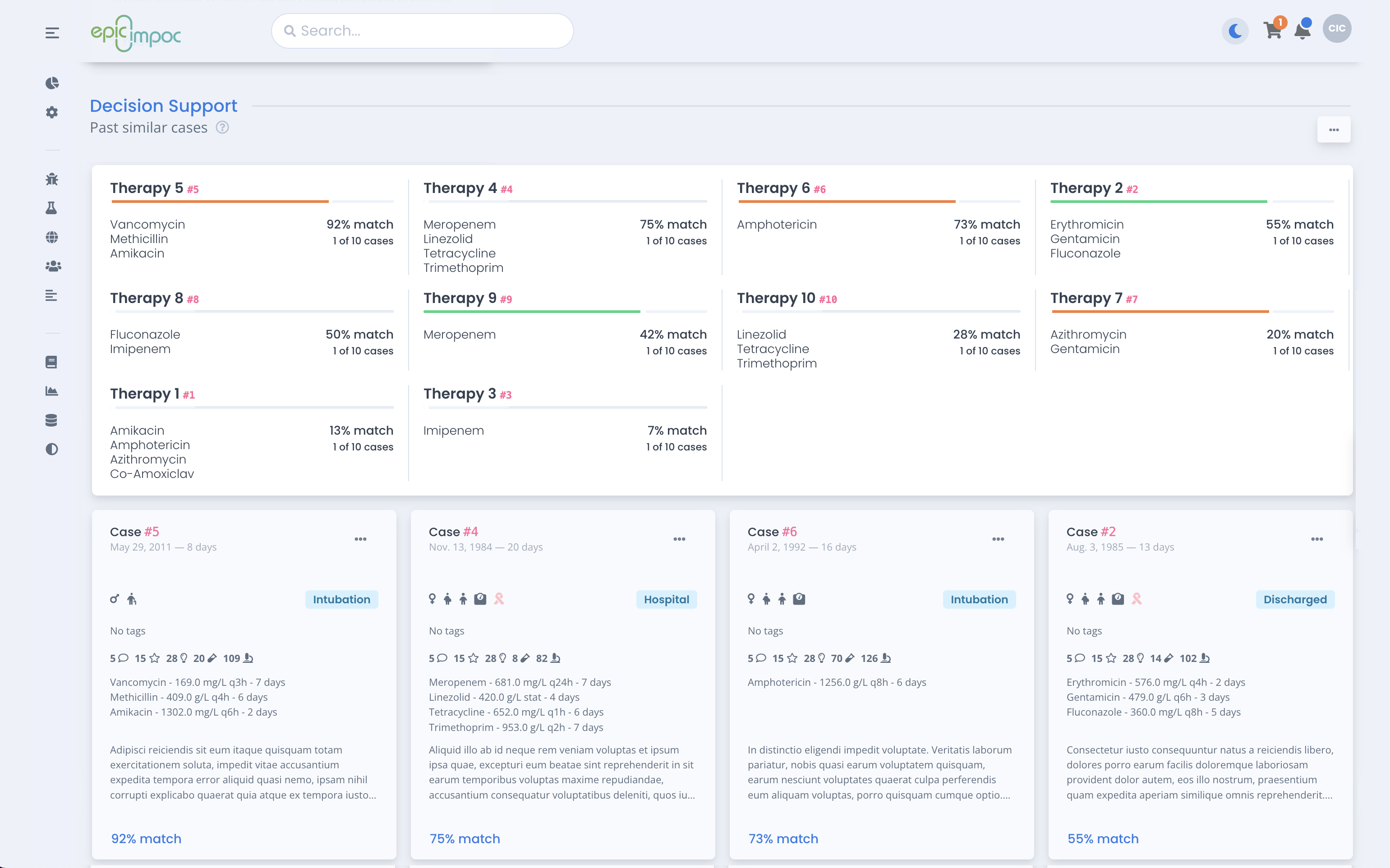EPiCIMPOC
Clinical decision support system (CDSS) to support infection management at the point of care.
Role: Conceptualization, architect, design, development and deployment on NHS.
Enhanced Personalized and Integrated Care for Infection Management at the Point of Care, or EPIC IMPOC, is an NIHR i4i funded project which aims to develop intelligent clinical decision support system to help doctors prescribe the most appropriate antibiotics. EPIC IMPOC is a collaborative project between medics and other healthcare professionals from the National Institute for Health Research Health Protection Research Unit (NIHR HPRU) and engineers from Centre for Bio-Inspired Technology (CBIT).
Healthcare professionals who diagnose and treat infections must often do so rapidly to prevent harm to their patients. Their prescribing decisions can be assisted by providing them with access to treatment recommendations, based on the most likely organism causing the infection (antimicrobial guidelines) and data on local antimicrobial resistance patterns.
These decision support systems are mostly rule-based, providing easy-to-access policies or guidelines. A new project started by the Faculty of Engineering and Medicine kickstart scheme, and now funded by the NIHR Invention for Innovation scheme has taken this further, developing anintelligent decision support system. This system is capable of considering a greater number of variables and a more complicated number of scenarios than other systems and by using a machine learning and artificial intelligence algorithms the system is able to continually learn from its previous experiences.
- The ability to display data from NHS servers on mobile and tablet devices at the patient bedside.
- Algorithms to provide advanced decision support for clinicians for optimised antimicrobial choices.
- A population pharmacometric model to provide individualised antimicrobial dosing.
- Patient engagement tools to facilitate shared decision making across complex health-care pathways

The modular design breaks down the system to reduce its complexity by encapsulating functionality and processes within reusable modules. An overview of these modules, ranging from patient administration and data collection to prognostic functionality is presented below.
Management
The "management" module serves as a central hub or interface that integrates information and data from various submodules such as microbiology, pathology, case-based reasoning, and more. Its primary functionality is to collect, organize, and present this data in a user-friendly manner. Some of the key functionality of these modules are: (i) gathers information from different submodules, (ii) organizes the information systematically based on different criteria, such as patient cases, medical conditions, or specific areas of interest (iii) provides a user-friendly interface to display the aggregated data, (iv) allows users to add their own notes and annotations to the collected data, (v) includes search functionality that enables users to quickly locate specific patients or filter data based on specific parameters and (vi) integration with other software systems or databases, facilitating seamless data exchange and interoperability.




Microbiology
Antimicrobial drugs are commonly used. We have all heard of antibiotics, which fight bacteria, but there are also antifungals, antivirals and antiparasitics that fight fungi, viruses and parasites, respectively. The more we use these drugs, the less effective they become and this problem is known as antimicrobial resistance (AMR). Resistant infections can be difficult, and sometimes impossible, to treat. Antimicrobial susceptibility testing (AST) is a laboratory method used to determine the effectiveness of antimicrobial agents against specific microorganisms. It helps in guiding appropriate antimicrobial therapy by providing valuable information about the susceptibility or resistance of bacteria, fungi, or other pathogens to different drugs. Therefore, the objective of the "microbiology" module has two main aspects. Firstly, it performs automated calculations based on AST data to measure resistance levels, monitor resistance changes over time, assess the effectiveness of different antimicrobials, and more. Secondly, it integrates these metrics into a clinical decision support system, so that healthcare providers can access real-time, data-driven insights to optimize antimicrobial therapy, improve patient outcomes, and mitigate the further development and dissemination of antimicrobial resistance.
Pathology
The "pathology" module is designed to streamline the collection, storage, and visualization of pathology laboratory tests, with a particular focus on scenarios where these tests are conducted frequently, such as on a daily basis. It provides a specialized framework to manage and analyze pathology data in a time series format.
Case-Based Reasoning
In clinical environments, physician reasoning is based on knowledge acquired from past cases personally experienced which is exactly what CBR does! The aim of CBR is to solve new problems based on the solutions of similar past problems in form of cases. CBR is considered a methodology to follow rather than an algorithm in itself. Initially, the CBR methodology requires a set of cases or training examples denoted as case-base. Then, for a specific query, the CBR retrieves those cases which are more similar including the treatments and the outcome.
Probabilistic Inference
In clinical environments, the acute infection management pathway followed by clinicians has been defined as a step-wise Bayesian model in which each step adds systematically information to optimise diagnosis and management of infection. First, they evaluate the physiological parameters of the patient and try to localise and confirm the infection. Then, physicians review and plan further investigations such as pathology laboratory tests, specimen collection for susceptibility testing or imaging. These previous steps allow physicians to construct a clinical picture of the severity of the infection. From this clinical picture, a decision to whether or not to initiate antimicrobial therapy is made with local microbiology guidance as a determinant factor. Finally, an internal and/or external review of the patient is conducted to refine the antimicrobial therapy and the entire process is repeated. Thus, the aim of this module is to provide support at the different stages of the infection management pathway to assess the likelihoods of a patient having an infection, the location of the infection, the overall severity of the patient and the risk of suffering complications in following days, among others.
Posts
- Featured in The Pharmaceutical Journal
- Featured innovative start-up at TechForesight 2040
- Included within Techcelerate's 3rd cohort entrepreneurial programme
- Featured in an ICL seminar
- Featured in the CBIT newsletter
- Information of the NIHR funding award
- Clinical trial registration in clinicaltrials.gov (pdf)
- Clinical trial registration in clinicaltrials.gov (web)
- Clinical trial registration in ichgcp.net (web)